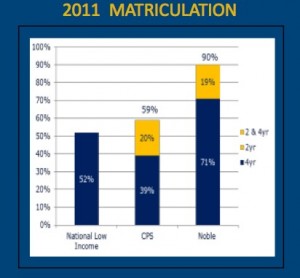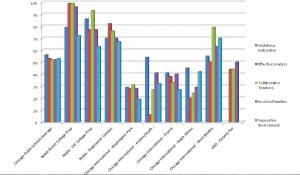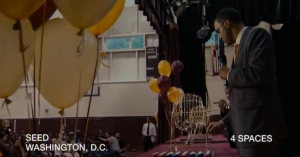As more high schools are opening and closing in the city of Chicago, more parents and future 9th grade students are taking advantage of public school choice and beginning to seek high schools that have established a reputation for producing results. High schools that have appealed to parents and students have ranged from magnet schools, montessori schools, traditional schools, and more recently charter schools. In the city of Chicago, approximately 19,000 students applied for admission to charter schools and over 23,000 are predicted to apply next year (1).The overwhelming amount of students applying to charter schools in the Chicagoland area causes a debate among the charter school community as to which of them has a better reputation as the “best” school to attend. When looking at all networks of charter high schools, one network has obtained both the most frequent media attention by the city of Chicago and produced effective results in standardized tests: the Noble Network of Charter Schools. With over 6,304 applications received by the Noble Network of Charter schools from 2010-2011, the amount of applicants for the 10 campuses leads one to wonder: how and why did the Noble Network of Charter Schools, compared to its competitors, become so popular in Chicago from 1999, when the network first opened, to the present?
There have been many reasons given by parents who have applied their children to a Noble charter high school as opposed to any other charter high school in Chicago. Noble’s college matriculation rates, their curricular focus, support, and their achievements with testing stand out among these as the critical deciding factors. Many other competitor networks of charter schools have similar practices to that of the Noble Network of Charter Schools; however, the Noble Network of Charter Schools produce some of the largest numbers of applicants growing larger and larger each year in the city of Chicago. Although Noble seems to operate just as every other network of charter schools does, Noble has certain characteristics that sets their schools apart from its competitors.
I personally decided to research this network of charter schools because I attended and graduated from one of the Noble Network of Charter Schools campuses. Also, I wanted to research the “The Noble Difference Campaign” in which the network prides themselves on and what I experienced in high school. Moreover in my own personal experience, the range of charter high schools is extremely competitive, and I wanted to research the reason behind the growing number of applications to Noble. The Noble Network of Charter Schools emerged in 1999 with the opening of its first campus, Noble Street Charter School an open enrollment charter high school. After its first graduating class in 2003, Noble expanded throughout the city of Chicago and has 13 campuses in a variety of neighborhoods including a middle school (2). The Noble Network of Charter Schools, like every other charter school in the city of Chicago, conducts a lottery every spring for applicants waiting to attend their schools. According to the Illinois Charter School Biennial Report, about 6,304 applications were received for the 10 campuses already established for the 2010-2011 school with only 1428 of those applicants admitted.
In considering different schools for their children, most parents try to choose a school that will keep their children on track for college and matriculate to college right after high school. College matriculation rates determines the number of students in which apply to college and attend right after graduating high school. When students walk into a Noble charter high schools, they are asked to sign a contract their first day of school freshman year. This contract is an agreement that the student makes with the staff and teachers of the school that their main goal in success and college in the long run. According to Angelica Alfaro, the alumni coordinator for Noble’s original campus, the college matriculation rate for the first graduating class was 81% (3). Today that rate has gradually increased with each campus having it’s own matriculation rate either at or above the original campus’s rate.

Moreover, the rates at which minorities are matriculating into college through a Noble Network Charter school is proving to be one of the highest especially compared to that of Chicago Public Schools in general. According to the Chicago Public Schools Office of College and Career Preparation in 2011, over 90% of Latino and African American students who graduate from a Noble high school matriculate into college (4). In attending a Noble charter high school, minority students are more likely to graduate from high school and matriculate into college than in traditional Chicago Public Schools system school. In knowing that students would be more likely to attend college after high school, students would be enrolled more likely in a Noble Network charter school as opposed to a school a part of the Chicago Public schools system.
At the heart of each school, curricular focus, which includes school environment, is one of the most important components to a student’s success in that schools because the type of education a student receives will ultimately determine his or her success beyond high school and on to college. Curricular focus is the type of environment that a student is immersed in, the people in the school community, as well as the loved ones at home who are aiding in the student’s success throughout their four years in high school. In considering curricular focus, the University of Chicago conducted a study called The 5 Essentials study which gives a picture of the type of school environment a school has without considering statistics and test scores (5). This study was administered to parents, teachers, and staff within each school and with each question centered on a specific category of the study. The study focused on five aspects of a school’s environment: ambitious instruction, effective leaders, collaborative teachers, involved families, and a supportive environment.

Compared to a few major Chicago charter schools and even the Chicago Public Schools system, Noble has campuses that prevail above every single one. Noble Street Charter Schools, Noble-UIC Campus, and Noble-Englewood Campus all have some of the highest scores in each of the 5 essentials category and beat out two of its competitor charter schools, Chicago International Charter Schools and an UNO Charter School campus (6) . Furthermore when looking into the 5 Essentials study at the University of Chicago website, every single noble campus has scored either an overall organized or well-organized review as a school which means in every category Noble has strong and very strong responses from parents, students, and staff (7). Overall the Noble Network of Charter Schools has demonstrated one of the strongest strong curricular focuses, as compared to two of its top competitors, centered on a strong environment present by the everyone in the network including students, staff, and parents.
When students are in high school, many of these students need the support of their loved ones as well as strong and supportive staff and teachers. Being able to have strong role models in the school as well as organization allows for students to transition smoothly into the groove of both high school and preparing themselves for college. As part of their vision for college preparation, the Noble Network of Charter Schools divides each grade level into ‘advisories’ and has one designated advisor for a group of anywhere between 10-30 students for their next four years at Noble. The advisor acts as a “life mentor” and aids their group of students in academics and makes sure that each student is both mentally and academically prepared for college (8). Having a mentor for their entire high school career and beyond helps these students connect with their peers as well as associate with their teachers on a personal level. Having that personal touch allows students to adjust to the rigors of both high school and college much more smoothly and have someone guide them through the process. Furthermore, teachers and students each treat each other with respect, which in most schools is an issue that becomes the center of disciplinary measures needing to be taken. According to Steven R. Covey the author of Leader in Me: How Schools and Parents Around the World Are Inspiring Greatness, One Child At a Time, “Students treat each other with respect [at Noble]. They also treat adults with respect, in large part because they are treated with respect”(9). Because the Noble Network of Charter Schools maintains this professional environment with the help of rules, and the staff and teachers treat students with respect and understanding, students are able to sit comfortable and create a healthy learning environment for themselves and others without any issues. The support given to students by teachers and staff that work for the Noble Network of Charter Schools relate to students at a personal level as well as a professional level which gives students the support they need to succeed the next four years at Noble and beyond.
Every spring, high school seniors all over Chicago dread the same fateful test that in their eyes determines the next few years of their life: the ACT. The ACT and prepping for the test has been one of the most important ideas centered on in high schools all over Chicago because of the impact it has on college admissions. Although according to a research brief by the Rand Corporation stated that the performance of charter high schools is “approximately on par with that of traditional publics schools in Chicago” (10), Noble has proven to rise above other non-selective high schools in the city. In order to make sure that Noble is being compared to only it’s competitors and not other traditional schools and selective enrollment schools, the charter high schools are compared to every non-selective enrollment high school in the city according to their average ACT score.

In the top ten highest performing non-selective high schools in Chicago of 2012 (according to the average ACT score), the Noble Network had 9 of their campus placed on the list including taking the first 8 spots (11). Having a majority of the Noble Network of Charter Schools campuses placed in the top ten of the highest performing non-selective high schools gives for a great reputation of sending students to top tier colleges and excellent ACT test preparation. This success posed by the Noble Network of Charter Schools demonstrates to parents that their children are able to take the ACT with the proper amount of preparation and gives students a confidence that they will be able to enter into the college or university of their dreams with the help of the Noble Network. Because of Noble’s impressive success with the ACT and its high ranks among their charter school peers, parents are more prone to choose Noble as a better route for their child’s future.
In the city of Chicago, there are over 600 public schools all together each with their own ways to manage their schools and perks. The Noble Network of Charter Schools has had some of the largest numbers of applications received as well as promising statistics of students who have attended the schools since its launch in 1999. The Noble Network of Charter Schools’ high college matriculation rates, strong curricular focus centered in school environment, support for students and parents, and their success with testing demonstrates to parents and future students the range of success that the network has had and why it is such a top competitor. With it’s growing number of applicants each year, it is clear why the Noble Network of Charter Schools appeal to parents and students looking for a school to help their children succeed throughout their high school career and continuing on into college.
(1). “Illinois Charter School Biennial Report.” www.isbe.state.il.us. Illinois State Board of Education, 12 Jan. 2013. Web. 11 Apr. 2013.
(2). “Mission & History.” www.noblenetwork.org. Noble Network of Charter Schools, 2012. Web. 11 Apr. 2013.
(3). Interview with Angelica Alfaro. Voice.
(4). Condition of Education, 2012; CPS Office of College and Career Preparation; National Clearinghouse, and internal tracking.
(5). Lowry, Bryan. “The Ins and Outs of Chicago’s Charter Network Expansion: What’s Working, What’s Not — and Why.” medill.northwestern.edu. Northwestern University, 31 Jan. 2013. Web. 13 Apr. 2013.
(6). “The University of Chicago Urban Education Institute.” uchicago.org. The University of Chicago, 31 Jan. 2013. Web. 14 Apr. 2013.
(7). Covey, Stephen R. The Leader In Me: How Schools and Parents Around the World Are Inspiring Greatness, One Child At A Time. New York: Free, 2008. 139-41. Print.
(8). Ibid.
(9). “Achievement and Attainment in Chicago Charter Schools.” Www.rand.org. The Rand Corporation, 23 Jan. 2008. Web. 17 Apr. 2013
(10). Dwyer, Josh. “Top Ten Charters Outperform Top Ten Open Enrollment, Non-selective, Traditional High Schools in Chicago.” illinoispolicy.org. Illinois Policy Institute, 8 Oct. 2012. Web. 18 Apr. 2013.





